zhou13 / Lcnn
Programming Languages
Projects that are alternatives of or similar to Lcnn
L-CNN — End-to-End Wireframe Parsing
This repository contains the official PyTorch implementation of the paper: Yichao Zhou, Haozhi Qi, Yi Ma. "End-to-End Wireframe Parsing." ICCV 2019.
Introduction
L-CNN is a conceptually simple yet effective neural network for detecting the wireframe from a given image. It outperforms the previous state-of-the-art wireframe and line detectors by a large margin. We hope that this repository serves as an easily reproducible baseline for future researches in this area.
Main Results
Qualitative Measures
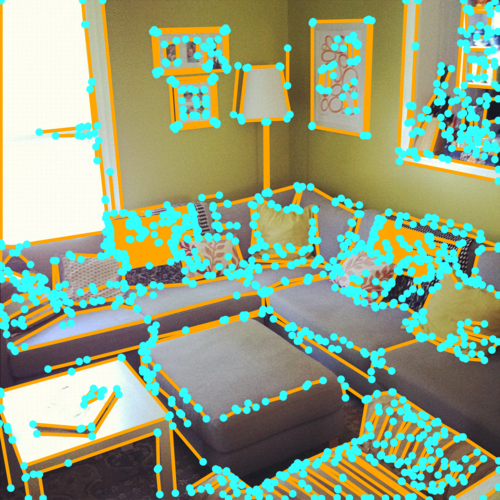 |
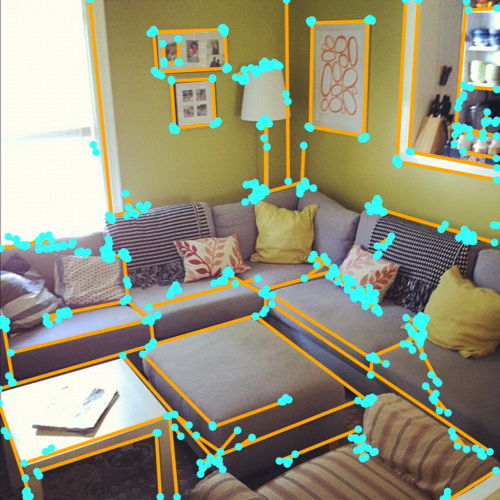 |
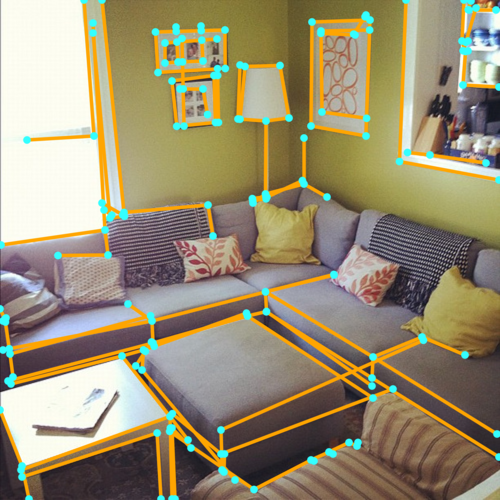 |
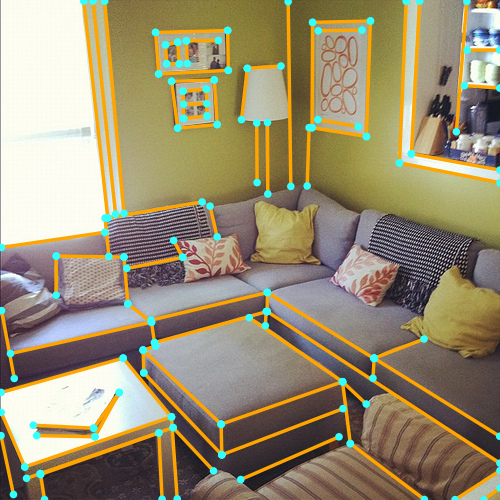 |
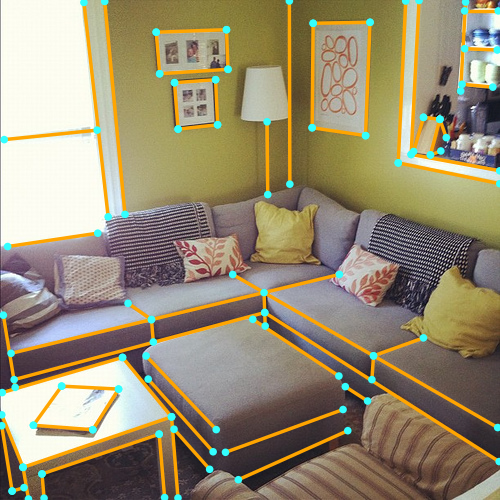 |
|---|---|---|---|---|
| LSD | AFM | Wireframe | L-CNN | Ground Truth |
More random sampled results can be found in the supplementary material of the paper.
Quantitative Measures
The following table reports the performance metrics of several wireframe and line detectors on the ShanghaiTech dataset.
| ShanghaiTech (sAP10) | ShanghaiTech (APH) | ShanghaiTech (FH) | ShanghaiTech (mAPJ) | |
|---|---|---|---|---|
| LSD | / | 52.0 | 61.0 | / |
| AFM | 24.4 | 69.5 | 77.2 | 23.3 |
| Wireframe | 5.1 | 67.8 | 72.6 | 40.9 |
| L-CNN | 62.9 | 82.8 | 81.2 | 59.3 |
Precision-Recall Curves
Code Structure
Below is a quick overview of the function of each file.
########################### Data ###########################
figs/
data/ # default folder for placing the data
wireframe/ # folder for ShanghaiTech dataset (Huang et al.)
logs/ # default folder for storing the output during training
########################### Code ###########################
config/ # neural network hyper-parameters and configurations
wireframe.yaml # default parameter for ShanghaiTech dataset
dataset/ # all scripts related to data generation
wireframe.py # script for pre-processing the ShanghaiTech dataset to npz
misc/ # misc scripts that are not important
draw-wireframe.py # script for generating figure grids
lsd.py # script for generating npz files for LSD
plot-sAP.py # script for plotting sAP10 for all algorithms
lcnn/ # lcnn module so you can "import lcnn" in other scripts
models/ # neural network structure
hourglass_pose.py # backbone network (stacked hourglass)
line_vectorizer.py # sampler and line verification network
multitask_learner.py # network for multi-task learning
datasets.py # reading the training data
metrics.py # functions for evaluation metrics
trainer.py # trainer
config.py # global variables for configuration
utils.py # misc functions
demo.py # script for detecting wireframes for an image
eval-sAP.py # script for sAP evaluation
eval-APH.py # script for APH evaluation
eval-mAPJ.py # script for mAPJ evaluation
train.py # script for training the neural network
post.py # script for post-processing
process.py # script for processing a dataset from a checkpoint
Reproducing Results
Installation
For the ease of reproducibility, you are suggested to install miniconda (or anaconda if you prefer) before following executing the following commands.
git clone https://github.com/zhou13/lcnn
cd lcnn
conda create -y -n lcnn
source activate lcnn
# Replace cudatoolkit=10.1 with your CUDA version: https://pytorch.org/
conda install -y pytorch cudatoolkit=10.1 -c pytorch
conda install -y tensorboardx -c conda-forge
conda install -y pyyaml docopt matplotlib scikit-image opencv
mkdir data logs post
Pre-trained Models
You can download our reference pre-trained models from Google
Drive. Those models were
trained with config/wireframe.yaml for 312k iterations. Use demo.py, process.py, and
eval-*.py to evaluate the pre-trained models.
Detect Wireframes for Your Own Images
To test LCNN on your own images, you need download the pre-trained models and execute
python ./demo.py -d 0 config/wireframe.yaml <path-to-pretrained-pth> <path-to-image>
Here, -d 0 is specifying the GPU ID used for evaluation, and you can specify -d "" to force CPU inference.
Downloading the Processed Dataset
Make sure curl is installed on your system and execute
cd data
../misc/gdrive-download.sh 1T4_6Nb5r4yAXre3lf-zpmp3RbmyP1t9q wireframe.tar.xz
tar xf wireframe.tar.xz
rm wireframe.tar.xz
cd ..
If gdrive-download.sh does not work for you, you can download the pre-processed dataset
wireframe.tar.xz manually from Google
Drive and proceed
accordingly.
Processing the Dataset
Optionally, you can pre-process (e.g., generate heat maps, do data augmentation) the dataset from
scratch rather than downloading the processed one. Skip this section if you just want to use
the pre-processed dataset wireframe.tar.xz.
cd data
../misc/gdrive-download.sh 1BRkqyi5CKPQF6IYzj_dQxZFQl0OwbzOf wireframe_raw.tar.xz
tar xf wireframe_raw.tar.xz
rm wireframe_raw.tar.xz
cd ..
dataset/wireframe.py data/wireframe_raw data/wireframe
Training
The default batch size assumes your have a graphics card with 12GB video memory, e.g., GTX 1080Ti or RTX 2080Ti. You may reduce the batch size if you have less video memory.
To train the neural network on GPU 0 (specified by -d 0) with the default parameters, execute
python ./train.py -d 0 --identifier baseline config/wireframe.yaml
Testing Pretrained Models
To generate wireframes on the validation dataset with the pretrained model, execute
./process.py config/wireframe.yaml <path-to-checkpoint.pth> data/wireframe logs/pretrained-model/npz/000312000
Post Processing
To post process the outputs from neural network (only necessary if you are going to evaluate APH), execute
python ./post.py --plot --thresholds="0.010,0.015" logs/RUN/npz/ITERATION post/RUN-ITERATION
where --plot is an optional argument to control whether the program should also generate
images for visualization in addition to the npz files that contain the line information, and
--thresholds controls how aggressive the post processing is. Multiple values in --thresholds
is convenient for hyper-parameter search. You should replace RUN and ITERATION to the
desired value of your training instance.
Evaluation
To evaluate the sAP (recommended) of all your checkpoints under logs/, execute
python eval-sAP.py logs/*/npz/*
To evaluate the mAPJ, execute
python eval-mAPJ.py logs/*/npz/*
To evaluate APH, you first need to post process your result (see the previous section).
In addition, MATLAB is required for APH evaluation and matlab should be under your
$PATH. The parallel computing toolbox is highly suggested due to the usage of parfor.
After post processing, execute
python eval-APH.py post/RUN-ITERATION/0_010 post/RUN-ITERATION/0_010-APH
to get the plot, where 0_010 is the threshold used in the post processing, and post/RUN-ITERATION-APH
is the temporary directory storing intermediate files. Due to the usage of pixel-wise matching,
the evaluation of APH may take up to an hour depending on your CPUs.
See the source code of eval-sAP.py, eval-mAPJ.py, eval-APH.py, and misc/*.py for more
details on evaluation.
Citing End-to-End Wireframe Parsing
If you find L-CNN useful in your research, please consider citing:
@inproceedings{zhou2019end,
author={Zhou, Yichao and Qi, Haozhi and Ma, Yi},
title={End-to-End Wireframe Parsing},
booktitle={ICCV 2019},
year={2019}
}
